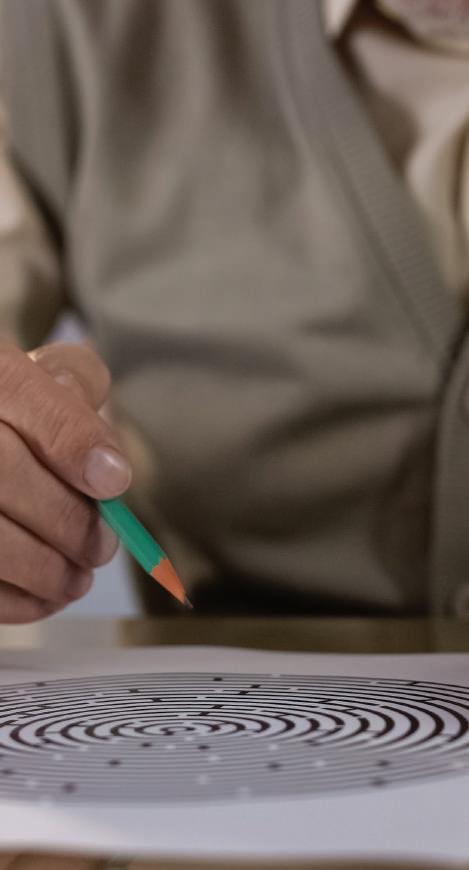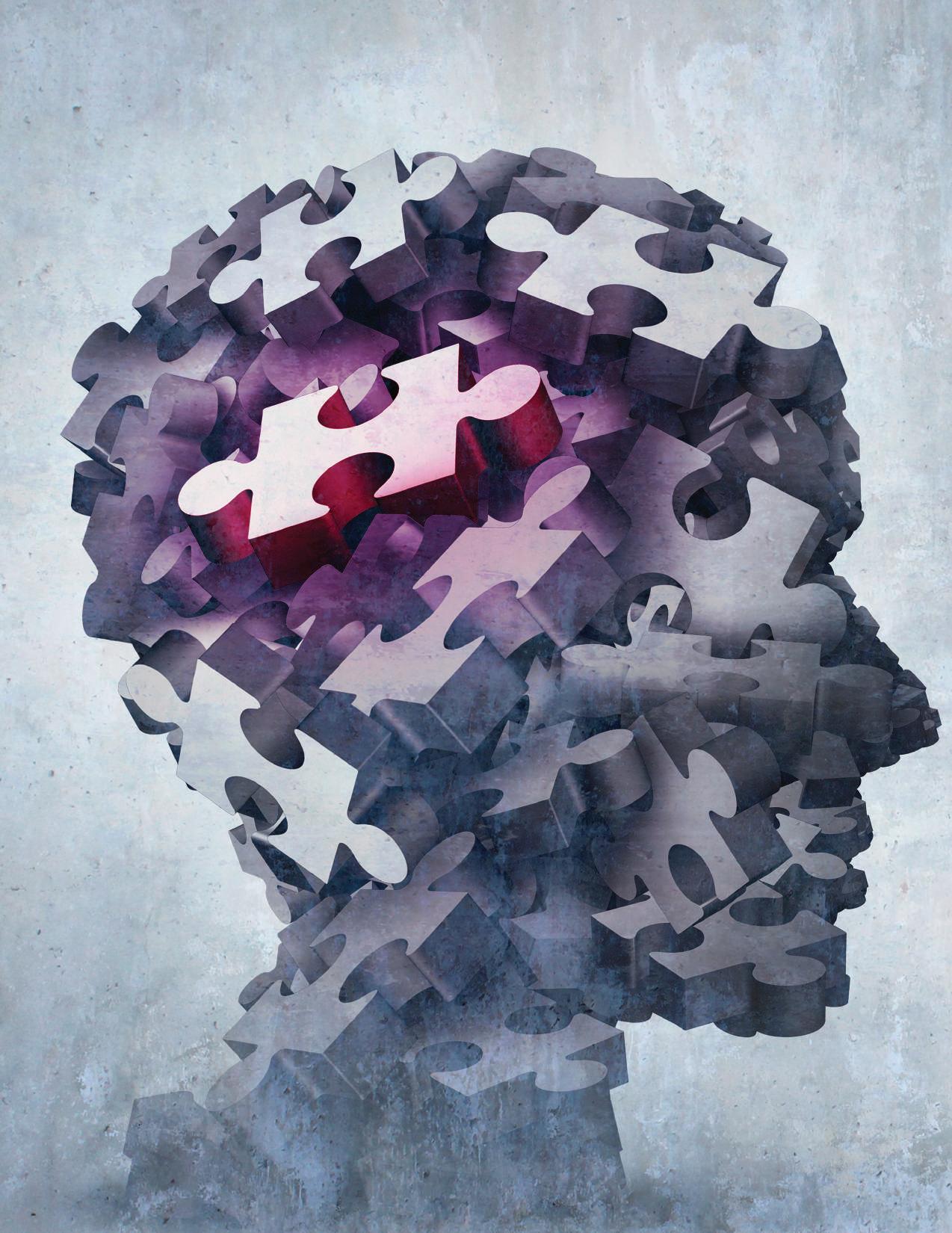






















(Chair) Gary W. Small, MD, Chair of Psychiatry, Hackensack University Medical Center, and Physician in Chief of Behavioral Health, Hackensack Meridian Health.
Gustavo Alva, MD, DFAPA, Medical Director, ATP Clinical Research, and Assistant Professor, Department of Neuroscience, University of California, Riverside.
Alexis Eastman, MD, Medical Director, Division of Geriatrics, UW Hospitals and Clinics, and Assistant Professor, University of Wisconsin School of Medicine and Public Health.
Michael B. First, MD, Professor of Clinical Psychiatry, Columbia University, and Research Psychiatrist, Biometrics Department, New York State Psychiatric Institute.
Gary Epstein-Lubow, MD, Associate Professor of Psychiatry and Human Behavior and Associate Professor of Medical Science, Alpert Medical School, and Associate Professor of Health Services, Policy and Practice, Brown University School of Public Health.
George T. Grossberg, MD, Samuel W. Fordyce Professor and Director of Geriatric Psychiatry, Department of Psychiatry and Behavioral Neuroscience, St. Louis University School of Medicine.
Daniel Press, MD, Associate Professor in Neurology, Harvard Medical School, and Director, Cognitive Neurology Unit, Beth Israel Deaconess Medical Center.
Susan Scanland, MSN, CRNP, GNP-BC, CEO & Founder, Dementia Connection®, Clarks Summit, PA.
Chad Worz, PharmD, BCGP, Executive Director and Chief Operating Officer, American Society of Consultant Pharmacists.
Karen Tracy, Vice President, Strategic Alliances and Integrated Communications, The Gerontological Society of America.
Judit Illes, BCL/LLB, MS, CPHQ, Director, Strategic Alliances, The Gerontological Society of America.
The mission of The Gerontological Society of America (GSA) is to: (1) promote the conduct of multiand interdisciplinary research in aging by expanding the quantity of gerontological research and by increasing its funding resources; (2) disseminate gerontological research knowledge to researchers, to practitioners, and to decision and opinion makers; and (3) promote, support, and advocate for aging education, and education and training in higher education. Copyright © 2021 by The Gerontological Society of America. All rights reserved.
This white paper was developed through an unrestricted grant from Acadia Pharmaceuticals, Inc

Symptoms of psychosis such as hallucinations and/or delusions commonly occur in people with dementia. While dementia-related psychosis can cause great distress to patients as well as their family members and caregivers, symptoms of psychosis in dementia are often not detected and managed until they have progressed in severity to the point of significant impact on patient health and caregiver burden. Moreover, the condition is associated with an increased risk of recurrent hospitalization and the need for more restrictive levels of care.
Because patients with dementia-related psychosis continue to receive suboptimal care, The Gerontological Society of America (GSA) established in 2019 a formal clinical workgroup of experts whose knowledge bridges disciplines, including primary care, neurology, psychiatry, and nursing. The workgroup has been meeting monthly to discuss the variety of challenges that persons with dementia-related psychosis and their caregivers encounter as they move through different health care settings and to propose some strategies to address these challenges, as summarized in the table below.
Table 1 : Challenges and Proposed Strategies for Persons With Dementia-Related Psychosis and Their
Challenges



Dementia-related psychosis is underdiagnosed and frequently undetected because of several di culties in de ning and assessing the condition.

Elicit symptoms from families, professional caregivers, and when possible, individuals with dementia.
Communicate with caregivers throughout the diagnostic process.
Tailor new educational content to various clinical disciplines and settings. Disseminate programs through online and in-person conferences and other venues as continuing education for providers.




Patients have limited access to the appropriate health care professionals at the appropriate time to help coordinate care.
Demand for a variety of specialists already exceeds supply or is expected to do so soon.
Train generalists via new modalities to support workforce expansion. Expand use of telehealth services such as:
• Telepsychiatry.
• Telementoring (e.g., Project ECHO).
Use embedded psychiatry models.



Treatment Challenges

Robust data are lacking relative to speci c nonpharmacologic therapeutic interventions for dementia-related psychosis.
As of December 2020, no antipsychotic agents are approved by the U.S. Food and Drug Administration (FDA) for the management of dementia-related psychosis.
Develop additional tools to optimize care for persons with dementia-related psychosis.
Create a guidance document with a standardized approach to address areas such as:
• Use of newer, safer pharmacologic treatments.
• Consideration of environmental triggers.
• Responding to delusion and hallucinations.
• Management of associated anxiety, irritability, and agitation.






Transitions can trigger episodes of psychosis in persons with dementia.
Create support and resources for caregivers, including respite care, disease education, caregiver training, support groups, adult day services, and other home- and community-based supports.
Develop and continuously update person-centered care plans.
Provide clearer communication of discharge instructions when patients transition out of the hospital setting.
After discharge, provide for more robust follow-up care, including transition coaches. Ensure proper coding and documentation of hallucinations and delusions.

Setting-Speci c Challenges: Health Systems



Clarity is lacking about which medical specialty should lead e orts to identify and manage dementia-related psychosis.
E orts are limited to bolster clinicians’ understanding of the signs and symptoms associated with dementia-related psychosis.
Sta time and nancial resources are lacking to appropriately evaluate dementia-related psychosis and counsel patients and caregivers about the condition.
Use a population-based approach to dementia care.
Integrate clinical protocols on dementia-related psychosis—such as the new International Psychogeriatric Association criteria—into electronic medical record platforms.
Modify payment models for better reimbursement.


Setting-Speci c Challenges: Long-Term

Lack of sta time and/or insu cient sta ng constrains individualized care and nonpharmacologic approaches.
Regulatory requirements such as gradual dose reductions and Star Ratings have led to decreased use of antipsychotics even when clinically warranted.
Extensive documentation on appropriateness of antipsychotic use is needed for compliance with government regulations.
Lack of surveyor training on dementia-related psychosis and appropriate management hinders quality of care.
Implement a team-based approach to address sta ng issues. Conduct additional research on standardized approaches to implementing nonpharmacologic interventions.
Provide additional training on documentation requirements, especially related to the prescribing of antipsychotic agents.
Collaborate with stakeholders to more meaningfully engage with the Centers for Medicare & Medicaid Services (CMS) and private players on issues such as:
• The latest clinical studies on safer medications.
• Exempting safer, FDA-approved antipsychotics from Star Ratings. Ease requirements around prior authorization to ensure continuity of care for patients when medications prove e ective.

Symptoms of psychosis, which are hallucinations and/or delusions, commonly occur in people with dementia.1 While dementia-related psychosis can cause great distress to the patient as well as the patient’s family members and caregivers, symptoms of psychosis in dementia are often not detected and managed until they have progressed in severity to the point of significant impact on patient health and caregiver burden. Moreover, the condition is associated with an increased risk of recurrent hospitalization and need for more restrictive levels of care.
To address unmet needs, The Gerontological Society of America (GSA) convened a multidisciplinary group of stakeholders in April 2019 to review care challenges affecting persons with dementia-related psychosis. The resulting GSA report Dementia-Related Psychosis: Gaps and Opportunities for Improving Quality of Care, which outlined gaps and opportunities for improving the quality of care of dementia-related psychosis, especially as it relates to coding and documentation, as identified by these stakeholders.
Because patients with dementia-related psychosis continue to receive suboptimal care, GSA established a formal clinical workgroup of experts in September 2020. The workgroup’s membership reflects multiple areas of expertise, including primary care, neurology, psychiatry, and nursing.
The charge of the workgroup was to highlight the variety of challenges that persons with dementia-related psychosis and their caregivers encountered during moves through different health care settings and propose strategies to address these challenges. Key challenges included these aspects of care of persons with dementia-related psychosis:
• Diagnosis.
• Timely access to care.
• Treatment.
• Transitions of care and distinct challenges to care in health systems and long-term care facilities.
This white paper provides a summary of the latest evidence on each distinct challenge and considerations for moving the field forward. While GSA and its clinical workgroup are committed to begin implementing some of the ideas articulated in this white paper, the participation of a variety of stakeholders—persons with dementia as well as advocacy groups, professional societies, health-system leaders, long-term care facility administrators, policymakers, government decision makers, and researchers—will be needed to change clinical practice and policy in positive ways.
GSA recognizes that the terminology used to describe dementia and its symptoms are continuously evolving to reflect both scientific progress and an increased understanding of how individuals experience stigma. To respect these changes but also keep the text accessible to a variety of audiences, this terminology is used in this white paper:
Dementia is used as an umbrella term that refers to a wide range of medical conditions caused by abnormal brain changes.2 These changes can cause a decline in thinking and problem-solving skills, also known as cognitive function, and interfere with daily activities. The changes can also affect behavior, feelings, and relationships. The newest Diagnostic and Statistical Manual of Mental Disorders, DSM-5, has replaced “dementia” with “neurocognitive disorder,” but this term is not yet widely used in the field.3
Psychosis is used to describe hallucinations and delusions. The term “psychotic” is avoided as a descriptor, even though it is still used in the medical literature and coding.
Clinical syndrome is used to describe a set of recognizable signs and symptoms that indicate a specific condition for which a direct cause is not necessarily understood.3
Person with dementia-related psychosis and “patient with dementia-related psychosis” are used interchangeably to remind readers that patients are, above all, individuals with unique preferences and values who can live life fully with dementia.
Family, family member, family caregiver, and caregiver are used interchangeably to mean “any relative, partner, friend, or neighbor who has a significant relationship with the person living with dementia-related psychosis. “
Dementia affects an estimated 14% of individuals ages 71 years or older in the United States.2 It is characterized by a decline in memory and other cognitive functions that results in a loss of independent functioning. Among the several types of dementia, Alzheimer’s disease is the most common. An estimated 5.8 million Americans ages 65 years or older are living with Alzheimer’s dementia, and this number is projected to rise to 13.8 million by 2050. Other types of dementia include vascular dementia, dementia with Lewy bodies, Parkinson’s disease dementia, and frontotemporal dementia.4
Neuropsychiatric symptoms are common in patients with dementia. These include depression, psychosis, agitation, aggression, apathy, anxiety, sleep disturbances, and disinhibition.5 Hallucinations and delusions are clinical symptoms of dementia that have a significant impact on patients and their caregivers. These symptoms occur across the various types of dementia and are associated with more rapid cognitive decline and other neuropsychiatric symptoms.6 In particular, visual hallucinations are a hallmark of Lewy body dementia. These symptoms manifest differently in those with dementia compared with patients with schizophrenia or other conditions that lead to psychosis.7
Overall, nearly 2.4 million people in the United States have dementia-related psychosis.8 A systematic review of 55 studies of psychosis in patients with possible or probable Alzheimer’s disease estimated that approximately 41% of patients had symptoms of psychosis, with delusions (median, 36%) being more common than hallucinations (median, 18%).9 These symptoms can be very distressing to the patient and have a significant impact on their activities of daily living and personal relationships.10 Other data have shown that these symptoms are linked to greater caregiver distress11 and are a significant predictor of future institutionalization and death.12


Overall, nearly 2.4 million people in the United States have dementia-related psychosis.8



A national shortage of 26,980 geriatricians is projected in the United States for 2025.16 By 2030, the ratio would be 1 geriatric psychiatrist for every 20,195 older adults.

While highly prevalent among certain types of dementia, dementia-related psychosis has been underdiagnosed and frequently undetected because of several difficulties in defining and assessing the condition. As with the underlying dementia, dementiarelated psychosis is a clinical syndrome—a cluster of signs and symptoms rather than a well-characterized disease with defined pathophysiologic characteristics. The Neuropsychiatric Inventory (NPI) delusions and hallucinations subscale may be used to diagnose dementia-related psychosis; however, it is complex and timeconsuming.13 As such, clinicians must rely on the recognition of this clinical syndrome based on a thorough medical history and examination.14 The diagnostic process requires clinicians to elicit clinical symptoms from families, professional caregivers, or even the patients themselves. It is important to communicate with caregivers throughout the diagnostic process. Many clinicians are challenged to do this since they may lack adequate training and experience.
When a clinician makes a diagnosis of dementia-related psychosis, it is important to search for underlying medical conditions that could be altering the patient’s mental status (e.g., infections, medication side effects, metabolic imbalances).1 The clinician also needs to differentiate dementia-related psychosis from other clinical syndromes (e.g., delirium, schizophrenia, psychotic depression).1
Differential diagnosis has been challenging because a precise definition of dementia-related psychosis was lacking.14 In September 2020, a workgroup of the International Psychogeriatric Association published a consensus definition of “psychosis” intended to move the field forward. While this definition holds promise, it has yet to be validated and operationalized in clinical settings.15
When determining that dementia-related psychosis is present, the clinician needs to differentiate between hallucinations and delusions or other neuropsychiatric symptoms. For example, a patient who has dementia and is upset may be agitated and anxious but might not experience hallucinations. Alternatively, a patient’s agitation may be the direct result of distressing hallucinations. It is up to the clinician to investigate the root cause of the patient’s distress and identify potential confounding factors. These factors make the early detection, assessment, and diagnosis of dementia-related psychosis an ongoing challenge and thereby complicate proper coding of the condition—as described in the later sections of this white paper describing difficulties during transitions of care and billing.
After receiving a diagnosis of dementia-related psychosis, patients are often referred to an academic memory center or a network of specialists that includes geriatricians, neurologists, geriatric psychiatrists, neuropsychologists, and nonphysician specialists. Yet even in instances when patients receive a timely diagnosis, they are unlikely to be able to access the appropriate health care professional at the appropriate time to help coordinate their care.
This lack of appropriate, coordinated care is especially but not exclusively the case in rural areas, where the demand for a variety of specialists already exceeds supply or is expected to do so in the near future.2 For example, a national shortage of 26,980 geriatricians is projected in the United States for 2025.16 By 2030, the ratio would be 1 geriatric psychiatrist for every 20,195 older adults.17 Similarly, a study of the current and future U.S. neurology workforce projects a 19% shortage of neurologists by 2025.18 Other professions have similarly low numbers of geriatric specialists, with only 4% of social workers and fewer than 1% of physician assistants identifying themselves as specializing in geriatrics; only about 2.6% of advanced nurse practitioners are certified in geriatrics and fewer than 1% of registered nurses and pharmacists are certified in this area.17
Clinical practice guidelines recommend the initial use of nonpharmacologic approaches to address neuropsychiatric symptoms in patients with dementia.19 Currently, there are no randomized, double-blind, placebo-controlled studies relative to specific nonpharmacologic interventions that are therapeutic for dementia-related psychosis; however, if the condition is not severe or having a profound impact, use of environmental manipulation may be useful.20
Further, the use of antipsychotic medications may be warranted if nonpharmacologic interventions are not working or when symptoms are severe, dangerous, and/or causing significant distress to the patient.19 As of December 2020, no antipsychotic agents were approved by the U.S. Food and Drug Administration (FDA) for the management of dementia-related psychosis; however, these agents have been used off-label and investigational agents are in development for this condition. Ongoing clinical development to treat neuropsychiatric symptoms of dementia, including dementia-related psychosis, is focused on increased safety and efficacy.


Ongoing clinical development to treat neuropsychiatric symptoms of dementia, including dementia-related psychosis, is focused on increased safety and efficacy.
Persons with dementia-related psychosis frequently transition across care settings (e.g., home, hospital, skilled nursing facilities) as their condition progresses, and these transitions present risks.21 Studies suggest that patients with dementia who are discharged from the hospital are at higher risk of medical rehospitalizations.22 According to clinicians’ experience, transitions can trigger episodes of psychosis in persons with dementia. Following discharge, the burden of providing adequate follow-up care (e.g., medication management) frequently falls upon unpaid caregivers.21 Thus, these transitions place great pressure on both family caregivers and providers to ensure that patients with dementia continue to have their clinical and psychosocial needs met regardless of setting. Educating caregivers (e.g., family, nonprofessionals) regarding dementia-related psychosis is essential so that they have the skills and resources (i.e., emotional, social, psychological, and/or technological) to continue helping their relatives or friends at home as well as the ability to share the status of patients’ conditions with health care providers.2 Additionally, avoiding rehospitalizations and minimizing the need for transitions are among the goals of long-term care.23
Low awareness of dementia-related psychosis may also exacerbate the risks. For example, patients with dementia presenting with delusions and/or hallucinations are often coded as having a “behavioral disturbance.”24 However, this code is not clinically reflective of psychosis, because “behavioral disturbance” is defined as behaviors that are aggressive, combative, or violent. This type of coding may detract from the accuracy of patient care plans and the appropriateness of medication, which are needed for proper care coordination across settings.8


According to clinicians’ experience, transitions can trigger episodes of psychosis in persons with dementia.
A variety of barriers within health systems may contribute to low rates of detection and diagnosis of dementia-related psychosis, resulting in suboptimal clinical management for patients.
A primary barrier to proper care within health systems is lack of clarity about which medical specialty should lead efforts to identify and manage this condition. While patients with dementia-related psychosis can benefit from oversight by primary care, neurology, and psychiatry, among other disciplines, these professionals still operate in silos in many health systems. No one specialty “owns” this clinical syndrome and the assessment and care management of the patients affected by it.
To further complicate matters, there have been limited efforts to bolster clinicians’ understanding of the signs and symptoms associated with this condition. Primary care providers, who would be ideally positioned to lead efforts to detect dementia-related psychosis early in the syndrome, have received limited training in the diagnosis and management of dementia and related neuropsychiatric symptoms.25,26 In a 2019 survey, 22% of providers had no residency training in dementia diagnosis and care, and 65% of those who had training reported the amount as “very little.”2 There are no data on the extent of primary care education on hallucinations and delusions in dementia, and 27% of physicians surveyed reported “never” or only “sometimes” feeling comfortable answering questions about dementia.2 While most general psychiatrists may regularly recognize and treat symptoms of psychosis due to their training, they may not be as comfortable evaluating patients for and managing dementia and dementiarelated psychosis. Similarly, while general neurologists have some familiarity with detecting and diagnosing dementia, they may be more challenged in addressing the neuropsychiatric symptoms of the syndrome such as dementia-related psychosis.

In a 2019 survey, 22% of providers had no residency training in dementia diagnosis and care, and 65% of those who had training reported the amount as “very little.”2


Beyond considerations related to workforce education and training, a significant number of clinicians in health systems simply lack the time and resources to appropriately evaluate dementia-related psychosis and counsel patients and caregivers about the condition.27,28 Routine office visits with primary care providers are typically 16 to 20 minutes per visit, which is inadequate when an extensive examination or family counseling is needed.28,29 Specialists typically have more time with patients (approximately 1 hour with new patients and 30 minutes for follow-up appointments). However, specialists can be challenged to address all cognitive, mood, safety, and health issues with a patient during the allotted time for visits, and the evaluation and management of dementia-related psychosis only adds to the complexity of medical issues that need to be covered.
Clinicians are also challenged to appropriately get reimbursed. In 2011, the Centers for Medicare & Medicaid Services (CMS) introduced Current Procedural Terminology (CPT) code 99483 to cover reimbursement for comprehensive dementia care. However, documentation requirements for this code are stringent, and uptake has been limited. For patients with dementia-related psychosis, there is still uncertainty around coding. The current International Classification of Diseases (ICD-10-CM) codes and instructional notes do not specifically delineate dementia-related psychosis.24
While a few health systems have recognized the need to prioritize dementia as a high-risk condition, most do not have special programs and incentives to address this area of medicine.
Patients with dementia-related psychosis often reside in long-term care facilities after families and caregivers are unable to manage the condition at home. For example, the presence of hallucinations in those with Alzheimer’s disease is associated with a twofold increase in the risk of institutionalization.30 Management of dementia-related psychosis requires a comprehensive treatment plan, which includes appropriate personcentered nonpharmacologic and pharmacologic interventions, as indicated.19 Behavioral interventions are preferred as the initial step in managing these patients, with appropriate staffing and education being paramount to ensuring these treatment modalities can be implemented in long-term care settings for behavioral symptoms. However, a variety of barriers, including limited staffing and staff training, and regulatory restrictions affecting prescribing, make it difficult to deliver person-centered care for individuals with dementiarelated psychosis in this setting.
Lack of staff time and/or insufficient staffing constrains the ability to individualize care and use nonpharmacologic approaches with residents. Many long-term care staff lack the knowledge, skills, or experience to implement nonpharmacologic interventions, or staffing issues limit the time to perform such interventions.31-33 An analysis of long-term care payrollbased data reveals large daily staffing fluctuations, low weekend staffing, and daily staffing levels often below CMS expectations.33 Because staff are primarily incentivized to complete tasks related to addressing residents’ more basic needs (e.g., activities of daily living), they often do not have time to learn about and employ nonpharmacologic interventions for behavioral symptoms with residents. In addition, facilities that have higher staff turnover or burnout tend to bring in temporary agency personnel, who tend to rotate through facilities and do not have the necessary time to get to know residents, which makes it difficult for such staff to implement nonpharmacologic interventions.

The current International Classification of Diseases (ICD-10-CM) codes and instructional notes do not specifically delineate dementia-related psychosis.24

While there is consensus in the clinical community that nonpharmacologic interventions should be first-line treatment of dementia-related psychosis, the use of antipsychotic medications is clinically warranted in some cases. The American Psychiatric Association guidelines recommend that in select patients, the risk/benefit assessment favors the use of an off-label antipsychotic to treat psychosis in patients with dementia, and treatment should be initiated at a low dose and titrated up to the minimum effective dose.19 However, the use of off-label antipsychotic agents in long-term care is a sensitive topic because of the historical use of these agents as chemical restraints. Clinicians must therefore document clearly and carefully the indication for which antipsychotic agents are needed. Because of regulatory requirements specific to long-term care settings, clinicians are challenged to consistently provide care that clinically benefits residents.
The final rule issued by CMS in 2016 (known as the Mega Rule) emphasized the need for programs in long-term care facilities to develop a patient-centric care plan for every new resident whose care is covered by Medicaid or Medicare.34 This rule continues to emphasize provisions that attempt to ensure the appropriate use of antipsychotics. Specifically, CMS has a gradual dose


reduction (GDR) requirement for antipsychotic medications, in which a stepwise reduction is required, unless clinically contraindicated, to determine if patients can tolerate lower doses of these medications or discontinue them completely. Clinicians are required to evaluate all residents on antipsychotic medications for a GDR within the first year that they reside in a facility or have been started on the medication. If not clinically contraindicated, then clinicians must attempt a GDR twice within the first year, with at least 1 month between attempts, and at least annually thereafter. CMS regulations state that enduring and progressive conditions may require treatment indefinitely and GDRs may be clinically contraindicated. The indications for use of an antipsychotic to treat an enduring condition should be updated to reflect the diagnosis of dementia-related psychosis as a single criterion for meeting the threshold of clinical necessity to use an FDA-approved antipsychotic. The GDR is a well-intentioned requirement but can lead to harm when applied broadly in some patient populations with valid reasons for using these medications, including those with dementia-related psychosis.

The GDR is a well-intentioned requirement but can lead to harm when applied broadly in some patient populations with valid reasons for using these medications, including those with dementia-related psychosis.

CMS’s Five-Star Quality Rating System for nursing facilities also addresses the use of antipsychotics in long-term care settings.35 Specifically, it measures residents on antipsychotics except those who have a diagnosis of schizophrenia, Huntington’s disease, or Tourette’s syndrome. These exclusions exist to avoid negatively impacting facilities’ ratings because those diagnoses are managed with antipsychotics with FDA-approved indications for use. Since these ratings directly correlate with both admissions and reimbursements, there are incentives for nursing homes to minimize the use of antipsychotics beyond these three indications.
However, this approach to assessing facilities does not accurately reflect the appropriateness of antipsychotic medication use and creates disadvantages for nursing facilities that lead to potential access and quality issues, especially for nursing homes with more residents with dementia who experience behavioral disturbances, including dementia-related psychosis. Nursing homes are not financially incentivized to accept dementia patients with behavioral disturbances such as dementia-related psychosis, and often, providers cannot find a nursing home willing to accept these patients, regardless of whether they are coming from home or the hospital.
GDRs and Star Ratings have led to a decrease in use of antipsychotics even in situations for which these agents may be clinically warranted for an FDA-approved indication, including Parkinson’s disease psychosis, major depression with psychosis, and bipolar disorder. Researchers are also studying medications for treatment of neuropsychiatric symptoms of dementia, including dementia-related psychosis. Increased use of sedative and nonsedative antidepressant agents
in long-term care settings has also been observed, suggesting that these agents are being used as substitutes for antipsychotic agents in management of neuropsychiatric symptoms.36 Patients with these symptoms would be better served by more specific, clinically indicated pharmacologic therapies.36,37
When antipsychotic agents are used in long-term care settings, extensive documentation in the medical record on appropriateness of use is needed for facilities to remain compliant with governmental regulations. Additionally, if a GDR is required, there are often no clear paths for providers to avoid them even when in the best interest of the patient. A provider may document a GDR as clinically contraindicated and document the clinical reasoning explaining why this intervention is inappropriate. Some state surveyors may find the documentation for a given facility insufficient, while others may accept it, thus creating uncertainty and deterring providers from using the most appropriate antipsychotic agents to manage their patients with dementia-related psychosis. Instead, clinicians avoid antipsychotic agents and use medications such as sedating psychotropic medications that have even less evidence of efficacy in this patient population.38 In addition, nursing homes may avoid admitting patients on antipsychotics in an attempt to keep their antipsychotic measures low. Strategies to circumvent the measure are an indictment of its lack of utility in measuring appropriate use. Proposed measures address the problems with the antipsychotic quality measure but have not yet been considered by CMS or passed into law by legislatures.39


Increased
use of sedative and nonsedative antidepressant agents in long-term care settings has also been observed, suggesting that these agents are being used as substitutes for antipsychotic agents in management of neuropsychiatric symptoms.36
Long-term care surveyors assess nursing homes across the United States to ensure quality care is being provided.40 These surveyors evaluate appropriate medication use, with a specific focus on antipsychotic agents and a goal of investigating the basis for treatment decisions and interventions affecting residents. Currently, surveyors focus on decreasing the overall use of antipsychotics in long-term care settings. However, surveyors receive limited training on dementia-related psychosis and how it is coded in clinical practice, which results in facilities being at greater risk for penalty when clinicians try to incorporate newer, evidence-based interventions/therapies. This gap in knowledge on appropriate use of antipsychotics and the value of treating patients with newer, safer medications prevents clinicians and facilities from improving quality of care.


For patients with dementia-related psychosis to receive better care, improved options are needed in several areas: early detection and diagnosis, facilitating access to care, better nonpharmacologic and pharmacologic treatment options, and better recognition and management of this condition in both acute and long-term care settings.
There are many opportunities to address the diagnostic challenges that subsequently hinder patients’ ability to receive timely care management and treatment for dementiarelated psychosis.
At the most fundamental level, new clinical and educational programming on dementia and dementia-related psychosis is a prerequisite for care teams to be able to accurately diagnose the syndrome. Educational content on dementia-related psychosis should be tailored to various clinical disciplines and settings; programs should be disseminated through online and in-person conferences and other venues for continuing education of health professionals.
An example of such an effort is the Clinician Partners Program at the Washington University School of Medicine in St. Louis, which was initiated to enhance Missouri’s rural health providers’ ability to diagnose and care for patients with dementia and increase clinical trial enrollment from rural communities.41 From 2000 to 2009, 146 health professionals attended a 3-day “miniresidency” program that focused on didactic, observational, and skill-based teaching techniques for managing dementia.42 In their evaluation of the program, providers reported having increased knowledge and confidence regarding the diagnosis, treatment, and management of the disease; recruitment to dementia research studies was also enhanced.
Another example is Dementia: A Comprehensive Update, a 3.5-day program offered by Harvard University for the past 24 years that covers the diagnosis and management of diseases associated with dementia. About 300 to 400 primary care and specialty physicians, nurse practitioners, physician assistants, nurses, psychologists, neuropsychologists, social workers, and physical and occupational therapists annually receive training through this program.43
Patient access to timely care interventions for dementia-related psychosis can be improved by expanding the existing workforce and health care infrastructure to support increasing patient demand. Approaches to workforce expansion include training generalists about new modalities and providing more services to patients through telehealth.
Unlike traditional telepsychiatry models, in which a psychiatrist consults with a single patient, telementoring connects specialists directly to primary care teams with the goal of building workforce capacity. Project ECHO (Extension for Community Healthcare Outcomes), based at the University of New Mexico Health Sciences Center, is a telementoring program that uses videoconferencing technology to transfer specialist knowledge and provide support to primary care teams.44 The model involves a collaboration between expert multidisciplinary specialist teams and primary care practices through sharing of information using case-based discussions and brief didactic presentations.
An example of the impact of Project ECHO on the management of patients with dementia and behavioral issues living in long-term care facilities is detailed in the ECHO-AGE model of geriatric care.45 An extension of Project ECHO, ECHO-AGE linked experts in the management of behavioral disorders in patients with dementia to nursing home care providers via a remote, casebased, video-consultation program. It resulted in increased adaptation of behavioral care

plans, clinical improvement of patients, and lower rates of hospitalizations in residents for whom recommendations were followed.45
The Alzheimer’s and Dementia Care ECHO Program is a specific initiative focused on connecting dementia care experts with health care teams from primary care practices.46 Telementoring may be an ideal option to help practitioners in the community manage the complex care of patients with dementia-related psychosis.
Integration of specialty care into primary care models is another solution to enhance access. The model known as embedded psychiatry places a consultant psychiatrist on site to assist primary care physicians in managing complex psychiatric issues. 47 These embedded specialists can either see patients for consultation visits or make recommendations to primary care providers via real-time consultations. For patients with dementiarelated psychosis, embedded specialists can aid in diagnostic clarity, medication assessment, and patient management.
Telehealth and telementoring can improve access to care in underserved areas. Telehealth is defined as a visit between a provider and patient that uses a telecommunications system.48 Of note, the Veterans Administration (VA) has been successfully using this modality of care for several years through the VIRTUAL Geriatrics (Veteran Interprofessional Rural Telehealth Linking Geriatrics Expertise for Education and Access) program, formerly known as GRECC Connect. It is a 15-site project that provides telementoring and telemedicine on all geriatric syndromes, including dementia-related psychosis.49 Telehealth has also proven to facilitate care beyond closed systems such as the VA. A systematic review of 68 studies in the area of geriatric telepsychiatry supported the use of telehealth in older adults for screening and diagnosis of cognitive disorders and enhancing community care for neurocognitive disorders.50
During the coronavirus pandemic, telehealth has become an essential service, especially for Medicare beneficiaries. Before the pandemic, only 14,000 beneficiaries received a Medicare telehealth service in a week; however, this number expanded to more than 10.1 million beneficiaries from mid-March through early July 2020.51 Previously, Medicare reimbursed for telehealth services only on a limited basis and had specific criteria for provision of payment for these services.52 Payment for telehealth was granted only when the patient receiving the service was in a designated rural area and had to travel to a clinic, hospital, or certain other types of medical facilities for telehealth services.
CMS temporarily broadened access to Medicare telehealth services in March 2020 to help limit the spread of the pandemic coronavirus, and the agency made many of the changes permanent in its December 2020 final rule.53,54 As part of these changes, CMS added many codes to the list of Medicare telehealth services eligible for reimbursement in a variety of settings (e.g., offices, hospitals, nursing facilities) across the country.55 The expansion of telehealth services can have a significant impact for patients with dementia-related psychosis. It opens an opportunity for family/caregivers to join health care appointments even when they are not in the same location as the patient.
Clinicians would benefit from additional tools and supports to optimize care for persons with dementia-related psychosis. Professional societies, such as the American Psychiatric Association, which have developed guidelines recommending the use of nonpharmacologic approaches as first-line therapy, should develop resources that can help clinicians operationalize their clinical recommendations and update guideline recommendations as newer, safer pharmacologic treatments are approved. While more research may be needed to make this kind of guidance possible, a standardized approach could include giving consideration to environmental triggers, responding to delusions and hallucinations, and addressing associated anxiety, irritability, and agitation.
Since transitions of care can sometimes trigger hallucinations and delusions in persons with dementia, it is important to minimize or delay such transitions by using new modalities of care such as telehealth. However, when transitions are necessary, several best practices can help reduce patient risk and assist caregivers, including the following:
Development of person-centered care plans that transcend settings but are also continuously updated based on the changing clinical and psychosocial needs of persons with dementia-related psychosis.21
Support and resources for caregivers, including respite care, disease education, caregiver training, support groups, adult day services, and other home and community-based supports since family caregiving continues regardless of setting.21
Clearer communication of discharge instructions when patients transition out of the hospital setting.
More robust post-discharge, follow-up care, with transition coaches and other approaches tested in the Care Transition Intervention model.56
Proper coding and documentation of hallucinations and delusions.24
For these best practices to be properly implemented, staff at all levels need an adequate level of knowledge about dementia and dementia-related psychosis so that they can account for the condition in discharge planning. A potential model for hospitals is the ongoing work in Massachusetts to build dementia-competent hospitals, pursuant to a law that was passed in 2018. The law requires hospitals to conduct training for all hospital staff on dementia diagnosis and management and be able to prepare dementia care plans by 2021.57 In sum, best practices are particularly important in health systems and long-term care facilities, because patients with dementia-related psychosis spend most of their time in these settings.

Since transitions of care can sometimes trigger hallucinations and delusions in persons with dementia, it is important to minimize or delay such transitions by using new modalities of care such as telehealth.


There is a need for a population-based approach to dementia care in which primary care providers identify, diagnose, and manage most persons living with dementia, and complex cases such as dementia-related psychosis are treated by an approach that includes more services.58 The University of California at Los Angeles Alzheimer’s and Dementia Care Program is a model initiating health system–based comprehensive dementia care management programs across the United States that use nurse practitioner dementia care managers.59 A clinical outcomes study using a variety of measures (i.e., the Mini-Mental State Examination [MMSE], the Functional Activities Questionnaire, Basic and Instrumental Activities of Daily Living scales, the Cornell Scale for Depression in Dementia, and Neuropsychiatric Inventory Questionnaire [NPI-Q] Severity) as well as caregiver measures (i.e., the Modified Caregiver Strain Index, the Patient Health Questionnaire-9, NPI-Q Distress, and the Dementia Burden Scale–Caregiver) was completed on 554 patients with dementia and their caregivers who had a 1-year follow-up.60 “Participants with ADRD [Alzheimer’s disease and related dementias] improved on all scales except MMSE and functional status measures; caregivers improved on all scales.”60

There is a need for a population-based approach to dementia care in which primary care providers identify, diagnose, and manage most persons living with dementia, and complex cases such as dementia-related psychosis are treated by an approach that includes more services.58

Another strategy is to integrate clinical protocols on dementia-related psychosis—such as the new International Psychogeriatric Association criteria—into electronic medical record (EMR) platforms. An example for dementia care is the ACT on Alzheimer’s EMR Decision Support Tools.61 These tools provide templates for clinicians to help standardize the approach to all aspects of dementia care within the health record. The templates cover screening, diagnosis, and treatment/management. Within the diagnosis templates, several sections are incorporated, including cognitive tests, appropriate documentation in the EMR, indications for specialty consultations, and diagnostic codes. The goal of these tools is to guide the provider toward best care practices and referrals to promote the care of patients with Alzheimer’s disease or a related dementia. The ACT on Alzheimer’s EMR Decision Support Tools can be used as a guide for practitioners in formulating specific approaches for properly documenting and coding dementiarelated psychosis. The appendix of this white paper contains examples of how to document a diagnosis of dementia-related psychosis with ICD-10-CM codes.
To overcome time and financial constraints, providers need to have a good understanding of billing requirements in order to be reimbursed for the appropriate intensity of each visit.28 However, payment models need to change so that reimbursements to primary care providers are appropriate for the amount of time needed for managing complex issues. The number and length of patient visits may also need to be modified to accommodate the needs of patients with dementia, including scheduling several clinic visits to address challenges and formulate solutions for patients and their families.19

Staffing issues in long-term care settings are well documented.33 These challenges can be at least partially addressed by implementing a team-based approach to individualizing the day-to-day care of residents. Data have shown that the overall penetration of daily practice teams in nursing homes is low, with current teams focused on developing resident care plans but not providing ongoing daily care.62 The formation of interdisciplinary care teams can help staff work more closely together to enhance the daily care of residents.
Staff from across professions can be educated on the care plan and held accountable for its implementation. For example, to address nursing staffing issues, certified nursing assistants can play a greater role in implementing nonpharmacologic strategies to help with the care of patients with dementia-related psychosis. As part of this education, interdisciplinary training can focus on increased recognition and understanding of symptoms of psychosis documented in the Long-Term Care Minimum Data Set. Physicians, nurses, certified nursing assistants, rehabilitation therapists, social workers, dietitians, and others can all work collaboratively to ensure patients are receiving comprehensive care.
A team-based approach holds all staff accountable and facilitates ongoing training and implementation of recommended interventions. Training should focus on teaching staff and health care providers how to implement nonpharmacologic interventions, when it is appropriate to initiate pharmacologic interventions, or when both interventions should be used. It is also important for long-term care staff to thoroughly understand the risks associated with the use of current antipsychotics in residents with dementia-related psychosis and to be informed of treatments in the pipeline that may offer a safer and effective alternative.
A variety of nonpharmacologic interventions can be employed to address behavioral and psychological symptoms of dementia in the domains of sensory practices, psychological practices, and structured care protocols.63 Research on standardized approaches to implementing nonpharmacologic interventions is currently limited; as this body of research expands, so will uptake by long-term care staff. The Tailored Activity Program for Persons With Dementia and Caregivers at Drexel University is an example of an individualized program for patients with dementia that focuses on reducing behavioral symptoms and improving patient care.64 The program teaches providers how to tailor activities to patients’ abilities and interests and gives them the skills to teach caregivers how to implement appropriate activities as part of the daily care plan. Activities and occupational therapists and other health care professionals who work closely with patients across a variety of care settings, including long-term care, are eligible to participate in the program.
Clinicians who treat residents with dementia-related psychosis would benefit from additional training on documentation requirements, especially related to the prescribing of antipsychotic agents. The content of this training would address appropriate documentation of the rationale underlying why a therapy may be maintained (i.e., if GDR is clinically contraindicated or if the condition is enduring). Key components of the documentation should include the demonstration of clinical benefit, how efficacy is being monitoring, any progression of symptoms, and safety. Education on how to use the EMR or other workflows to make documentation more efficient would also be of value to prescribers.
In areas where policies may not always keep up with the speed of scientific progress, there is an opportunity for professional societies, patient advocacy groups, and other stakeholders to more meaningfully engage with CMS and private payers on a variety of issues, including the following:
• The latest clinical studies on safer medications that may clinically benefits patients with dementia-related psychosis in the future.
• The pros and cons of exempting safer, FDA-approved antipsychotic medications from Star Rating calculations.
• Easing of requirements around prior authorization to ensure continuity of care for patients when medications prove effective.
a In its December 2020 proposed rule, CMS has recommended ways to reduce provider burden and streamline processes related to prior authorization.65,66

The Project PAUSE (Psychoactive Appropriate Use for Safety and Effectiveness) coalition consists of patient and professional organizations that advocate on clinical, regulatory, and legislative issues impacting long-term care.39 Its members are seeking to increase recognition of FDA-approved uses of antipsychotics in CMS policy and the incorporation of new clinical research on antipsychotic medications into approaches to care that can improve the management of neuropsychiatric symptoms of dementia. The coalition supports having strong documentation from the prescriber, the consultant pharmacist, and the medical team as the basis for identifying inappropriate use of antipsychotic medications as well as increased training for CMS surveyors on the topic. The Project PAUSE coalition is also recommending legislative actions to increase the opportunities for training of long-term care medical, nursing, and clinical staff. The Milken Institute’s Alliance to Improve Dementia Care is another organization currently working on building a dementia-capable workforce and system to support individuals living with dementia.67
Better care of patients with dementia-related psychosis requires new initiatives and advocacy at several levels. Research into optimal nonpharmacologic and pharmacologic interventions is ongoing, and education of health care providers, patients, family, and caregivers is needed.
With additional training in dementia and related syndromes, primary care providers could enhance care for patients with dementia-related psychosis by detecting and diagnosing this condition at earlier stages. New modalities for delivering patient care—including the use of contemporary telehealth systems and electronic medical records—could also improve care management for dementia-related psychosis.
Because patients with dementia-related psychosis who transition across settings of care may be at risk for worsening symptoms, such transitions should occur only when mandatory and be carefully managed by health care professionals who have experience specific to the care of persons with dementia. In long-term care settings, team-based approaches to care and additional education for staff, as well as surveyors, could help enhance resident quality of life and support guideline-based care.
Through advocacy and implementation of the strategies outlined in this white paper, stakeholders in the field of dementia-related psychosis can work toward improving care for patients with this high-burden condition.


A variety of nonpharmacologic interventions can be employed to address behavioral and psychological symptoms of dementia in the domains of sensory practices, psychological practices, and structured care protocols.63
1. Brendel RW, Stern TA. Psychotic symptoms in the elderly. Prim Care Companion J Clin Psychiatry. 2005;7(5):238–241. doi: 10.4088/pcc.v07n0506
2. Alzheimer’s Association. 2020 Alzheimer’s Disease Facts and Figures. 2020. Accessed October 23, 2020. https://www.alz.org/media/Documents/ alzheimers-facts-and-figures.pdf
3. American Psychiatric Association. Diagnostic and Statistical Manual of Mental Disorders (DSM–5). Washington, DC: American Psychiatric Association; 2020.
4. Plassman BL, Langa KM, Fisher GG, et al. Prevalence of dementia in the United States: the aging, demographics, and memory study. Neuroepidemiology. 2007;29(1–2):125–132. doi: 10.1159/000109998
5. Phan SV, Osae S, Morgan JC, Inyang M, Fagan SC. Neuropsychiatric symptoms in dementia: considerations for pharmacotherapy in the USA. Drugs R D. 2019;19(2):93–115. doi: 10.1007/s40268-019-0272-1
6. Karameh WK, Murari G, Schweizer TA, Munoz DG, Fischer CE. Psychosis in neurodegenerative disorders: recent developments. Curr Opin Psychiatry. 2019;32(2):117–122. doi: 10.1097/YCO.0000000000000476
7. Jeste DV, Finkel Sl. Psychosis of Alzheimer’s disease and related dementias: diagnostic criteria for a distinct syndrome. Am J Geriatr Psychiatry. 2000;8(1):29–34. doi: 10.1097/00019442-200002000-00004
8. Gerontological Society of America. Dementia-Related Psychosis: Gaps and Opportunities for Improving Quality of Care. August 2019. Accessed October 23, 2020. https://www.geron.org/images/documents/dementiarelatedpsychosis2019.pdf
9. Ropacki SA, Jeste DV. Epidemiology of and risk factors for psychosis of Alzheimer’s disease: a review of 55 studies published from 1990 to 2003. Am J Psychiatry. 2005;162(11):2022–2030. doi: 10.1176/appi.ajp.162.11.2022
10. Brandt T, Frangiosa T, Biggar V, Taylor A, Keller B, Abler V. Dementia-related psychosis symptoms and impact from the patient and care partner (caregiver) perspective: an observational, prospective study to describe the patient experience. Presented virtually at: Alzheimer’s Association International Conference 2020. Poster 47164.
11. Donaldson C, Tarrier N, Burns A. Determinants of carer stress in Alzheimer’s disease. Int J Geriatr Psychiatry. 1998;13(4):248–256. doi: 10.1002/ (sici)1099-1166(199804)13:4<248::aid-gps770>3.0.co;2-0
12. Magni E, Binetti G, Bianchetti A, Trabucchi M. Risk of mortality and institutionalization in demented patients with delusions. J Geriatr Psychiatry Neurol. 1996;9(3):123–126. doi: 10.1177/089198879600900303
13. Cummings JL. The Neuropsychiatric Inventory: assessing psychopathology in dementia patients. Neurology. 1997;48(5 Suppl 6):S10–S16. doi: 10.1212/wnl.48.5_suppl_6.10s
14. Cohen-Mansfield J, Golander H. The measurement of psychosis in dementia: a comparison of assessment tools. Alzheimer Dis Assoc Disord. 2011;25(2):101–108. doi: 10.1097/WAD.0b013e3181f811f4
15. Cummings J, Pinto CL, Cruz M, et al. Criteria for psychosis in major and mild neurocognitive disorders: International Psychogeriatric Association (IPA) consensus clinical and research definition. Am J Geriatr Psychiatry. 2020;28(12):1256–1269. doi: 10.1016/j.jagp.2020.09.002
16. U.S. Department of Health and Human Services, Health Resources and Services Administration, National Center for Health Workforce Analysis. National and Regional Projections of Supply and Demand for Geriatricians: 2013–2025. Rockville, MD: Health Resources and Services Administration; 2017.
17. Institute of Medicine, Committee on the Future Health Care Workforce for Older Americans. Retooling for an Aging America: Building the Health Care Workforce. Washington, DC: The National Academies Press; 2008.
18. Dall TM, Storm MV, Chakrabarti R, et al. Supply and demand analysis of the current and future US neurology workforce. Neurology. 2013;81(5):470–478. doi: 10.1212/WNL.0b013e318294b1cf
19. Reus VI, Fochtmann LJ, Eyler AE, et al. The American Psychiatric Association practice guideline on the use of antipsychotics to treat agitation or psychosis in patients with dementia. Am J Psychiatry. 2016;173(5):543–546. doi: 10.1176/appi.ajp.2015.173501
20. Kales HC, Gitlin LN, Lyketsos CG. Assessment and management of behavioral and psychological symptoms of dementia. BMJ. 2015;350:h369. doi: 10.1136/bmj.h369
21. Advisory Council on Alzheimer’s Research, Care, and Services. Public Members of the Advisory Council on Alzheimer’s Research, Care, and Services: 2020 Recommendations. 2020. Accessed December 2, 2020. https://aspe.hhs.gov/system/files/pdf/263911/2020PubMemRec.pdf
22. Pickens S, Naik AD, Catic A, Kunik ME. Dementia and hospital readmission rates: a systematic review. Dement Geriatr Cogn Dis Extra. 2017;7(3): 346–353. doi: 10.1159/000481502
23. Epstein-Lubow G, Fulton AT. Post-hospital transitions for individuals with moderate to severe cognitive impairment. Ann Longterm Care. 2012;20(3):18–24.
24. Gerontological Society of America. ICD-10 Codes for Documenting Dementia-Related Psychosis: An Expert Roundtable Summary. Washington, DC: Gerontological Society of America; April 25, 2019. www.geron.org/programs-services/alliances-and-multi-stakeholder-collaborations/dementiarelated-psychosis
25. Shadid AM, Aldayel AY, Shadid A, et al. Extent of and influences on knowledge of Alzheimer’s disease among undergraduate medical students. J Family Med Prim Care. 2020;9(7):3707–3711. doi: 10.4103/jfmpc.jfmpc_113_20
26. Jacinto AF, Villas Boas PJF, Mayoral VFS, Citero VA. Knowledge and attitudes towards dementia in a sample of medical residents from a universityhospital in São Paulo, Brazil. Dement Neuropsychol. 2016;10(1):37–41. doi: 10.1590/S1980-57642016DN10100007
27. Bradford A, Kunik ME, Schulz P, Williams SP, Singh H. Missed and delayed diagnosis of dementia in primary care: prevalence and contributing factors. Alzheimer Dis Assoc Disord. 2009;23(4):306–314. doi: 10.1097/WAD.0b013e3181a6bebc
28. Foster NL. Barriers to treatment: the unique challenges for physicians providing dementia care. J Geriatr Psychiatry Neurol. 2001;14(4):188–198. doi: 10.1177/089198870101400404
29. Shaw MK, Davis SA, Fleischer AB, Feldman SR. The duration of office visits in the United States, 1993 to 2010. Am J Manag Care. 2014;20(10):820–826.
30. Gilley DW, Bienias JL, Wilson RS, Benett DA, Beck TL, Evans DA. Influence of behavioral symptoms on rates of institutionalization for persons with Alzheimer’s disease. Psychol Med. 2004;34(6):1129–1135. doi: 10.1017/s0033291703001831
31. Kolanowski A, Van Haitsma V, Penrod J, et al. “Wish we would have known that!” communication breakdown impedes person-centered care. Gerontologist. 2015;55(Suppl 1):S50–S60. doi: 10.1093/geront/gnv014
32. Marx KA, Stanley IH, Van Haitsma K, et al. Knowing versus doing: education and training needs of staff in a chronic care hospital unit for individuals with dementia. J Gerontol Nurs. 2014;40(12):26–37. doi: 10.3928/00989134-20140905-01
33. Geng F, Stevenson DG, Grabowksi DC. Daily nursing home staffing levels highly variable, often below CMS expectations. Health Aff (Millwood). 2019;38(7):1095–1100. doi: 10.1377/hlthaff.2018.05322
34. Centers for Medicare and Medicaid Services. Medicare and Medicaid Programs; Reform of Requirements for Long-Term Care Facilities: Final Rule. Accessed November 5, 2020. http://www.federalregister.gov/documents/2016/10/04/2016-23503/medicare-and-medicaid-programs-reform-ofrequirements-for-long-term-care-facilities
35. Centers for Medicare and Medicaid Services. Five-Star Quality Rating System. Accessed November 5, 2020. https://www.cms.gov/Medicare/ProviderEnrollment-and-Certification/CertificationandComplianc/FSQRS
36. Vasudev A, Shariff SZ, Liu K, et al. Trends in psychotropic dispensing among older adults with dementia living in long-term care facilities: 2004–2013. Am J Geriatr Psychiatry. 2015;23(12):1259–1269. doi: 10.1016/j.jagp.2015.07.001
37. Maust DT, Kim HM, Chiang C, Kales HC. Association of the Centers for Medicare & Medicaid Services’ National Partnership to Improve Dementia Care With the Use of Antipsychotics and Other Psychotropics in Long-Term Care in the United States From 2009 to 2014. JAMA Intern Med. 2018;178(5):640–647. doi: 10.1001/jamainternmed.2018.0379
38. Fazio S, Zimmerman S, Doyle PJ, et al. What is really needed to provide effective, person-centered care for behavioral expressions of dementia? Guidance from the Alzheimer’s Association Dementia Care Provider Roundtable. J Am Med Dir Assoc. 2020;21:1582–1586.e1. doi: 10.1016/j. jamda.2020.05.017
39. Alliance for Aging Research, American Association for Geriatric Psychiatry, American Association of Post-Acute Care Nursing, et al. Project PAUSE: Effective Solutions for Improving Clinical Care in Long-Term Care Settings. Accessed October 27, 2020. www.agingresearch.org/app/ uploads/2020/12/Project_PAUSE_Final.pdfhttps://www.agingresearch.org/app/uploads/2020/10/Project_PAUSE_Final.pdf
40. Centers for Medicare and Medicaid Services. State Operations Manual; Appendix PP–Guidance to Surveyors for Long Term Care Facilities. November 22, 2017. Accessed October 26, 2020. https://www.cms.gov/Regulations-and-Guidance/Guidance/Manuals/downloads/som107ap_pp_guidelines_ltcf.pdf
41. Knight Alzheimer Disease Research Center. Clinician Partners Program. Accessed October 25, 2020. https://knightadrc.wustl.edu/education/cpp.htm
42. Galvin JE, Meuser TM, Morris JC. Improving physician awareness of Alzheimer disease and enhancing recruitment: the Clinician Partners Program. Alzheimer Dis Assoc Disord. 2012;26(1):61–67. doi: 10.1097/WAD.0b013e318212c0df
43. Harvard Medical School. Dementia: A Comprehensive Update. Accessed November 29, 2020. https://cmeregistration.hms.harvard.edu/events/ dementia-a-comprehensive-update/event-summary-58baf44f5a8c4f098e425c4797fd0abf.aspx?dvce=1
44. University of New Mexico. Project ECHO. Accessed October 25, 2020. https://hsc.unm.edu/echo/
45. Catic AC, Mattison MLP, Bakaev I, et al. ECHO-AGE: an innovative model of geriatric care for long-term care residents with dementia and behavioral issues. J Am Med Dir Assoc. 2014;15(12):938–942. doi: 10.1016/j.jamda.2014.08.014
46. Alzheimer’s Association. The Alzheimer’s and Dementia Care ECHO Program. Accessed October 25, 2020. https://www.alz.org/professionals/healthsystems-clinicians/echo-alzheimers-dementia-care-program
47. Butler DJ, Fons D, Fisher T, et al. A review of the benefits and limitations of a primary care–embedded psychiatric consultation service in a medically underserved setting. Int J Psychiatry Med. 2018;53(5–6):415–426. doi: 10.1177/0091217418791456
48. Centers for Medicare and Medicaid Services. Long-Term Care Nursing Homes Telehealth and Telemedicine Tool Kit. March 27, 2020. Accessed October 25, 2020. https://www.cms.gov/files/document/covid-19-nursing-home-telehealth-toolkit.pdf
49. Geriatric Scholars. VIRTUAL Geriatrics/GRECC Connect. Accessed December 1, 2020. https://www.gerischolars.org/mod/page/view.php?id=1066
50. Gentry MT, Lapid MI, Rummans TA. Geriatric telepsychiatry: systematic review and policy considerations. Am J Geriatr Psychiatry. 2019;27(2):109–127. doi: 10.1016/j.jagp.2018.10.009
51. Centers for Medicare and Medicaid Services. Trump Administration proposes to expand telehealth benefits permanently for Medicare beneficiaries beyond the COVID-19 public health emergency and advances access to care in rural areas [press release]. August 3, 2020. Accessed November 29, 2020. https:// www.cms.gov/newsroom/press-releases/trump-administration-proposes-expand-telehealth-benefits-permanently-medicare-beneficiaries-beyond
52. Centers for Medicare and Medicaid Services. Medicare Telemedicine Health Care Provider Fact Sheet. March 17, 2020. Accessed October 25, 2020. https://www.cms.gov/newsroom/fact-sheets/medicare-telemedicine-health-care-provider-fact-sheet
53. Centers for Medicare and Medicaid Services. President Trump expands telehealth benefits for Medicare beneficiaries during COVID-19 outbreak [press release]. March 17, 2020. Accessed October 25, 2020. https://www.cms.gov/newsroom/press-releases/president-trump-expands-telehealthbenefits-medicare-beneficiaries-during-covid-19-outbreak
54. Centers for Medicare and Medicaid Services. Trump Administration finalizes permanent expansion of Medicare telehealth services and improved payment for time doctors spend with patients [press release]. December 1, 2020. Accessed December 16, 2020. https://www.cms.gov/newsroom/ press-releases/trump-administration-finalizes-permanent-expansion-medicare-telehealth-services-and-improved-payment
55. Center for Connected Health Policy/Public Health Institute. Finalized CY2021 Medicare Physician Fee Schedule. December 2020. Accessed December 16, 2020. https://www.cchpca.org/sites/default/files/2020-12/CY%202021%20Medicare%20Physician%20Fee%20Schedule.pdf
56. The Care Transitions Program. About the Care Transitions Intervention. Accessed October 25, 2020. https://caretransitions.org/about-the-caretransitions-intervention
57. Knowles M. Massachusetts hospitals required to develop dementia care plan by 2021. Becker’s Clinical Leadership and Infection Control. August 13, 2018. Accessed November 29, 2020. https://www.beckershospitalreview.com/quality/massachusetts-hospitals-required-to-develop-dementia-care-plan-by-2021.html
58. Haggerty KL, Epstein-Lubow G, Spragens LH, et al. Recommendations to improve payment policies for comprehensive dementia care. J Am Geriatr Soc. 2020;68(11):2478–2485. doi: 10.1111/jgs.16807
59. Reuben DB, Evertson LC, Wenger NS, et al. The University of California at Los Angeles Alzheimer’s and Dementia Care program for comprehensive, coordinated, patient-centered care: preliminary data. J Am Geriatr Soc. 2013;61(12):2214–2218. doi: 10.1111/jgs.12562
60. Reuben DB, Tan ZS, Romero T, Wenger NS, Keeler E, Jennings LA. Patient and caregiver benefit from a comprehensive dementia care program: 1-year results from the UCLA Alzheimer’s and Dementia Care program. J Am Geriatr Soc. 2019;67(11):2267–2273. doi: 10.1111/jgs.16085
61. ACT on Alzheimer’s. EMR Decision Support Tools for Alzheimer’s and Related Dementias. 2016. Accessed October 24, 2020. https://actonalz.org/ sites/default/files/documents/ACT-Provider-EMRManual.pdf
62. Temkin-Greener H, Cai S, Katz P, Zhao H, Mukamel DB. Daily practice teams in nursing homes: evidence from New York state. Gerontologist. 2009;49(1):68–80. doi: 10.1093/geront/gnp011
63. Scales K, Zimmermann S, Miller SJ. Evidence-based nonpharmacological practices to address behavioral and psychological symptoms of dementia. Gerontologist. 2018;58(Suppl 1):S88–S102. doi: 10.1093/geront/gnx167
64. Drexel University. New Ways for Better Days: Tailored Activity Program (TAP) for Persons With Dementia and Caregivers. Accessed October 27, 2020. https://duo.online.drexel.edu/new-ways-for-better-days/
65. Centers for Medicare and Medicaid Services. CMS proposes new rules to address prior authorization and reduce burden on patients and providers [press release]. December 10, 2020. Accessed December 16, 2020. https://www.cms.gov/newsroom/press-releases/cms-proposes-new-rulesaddress-prior-authorization-and-reduce-burden-patients-and-providers
66. U.S. Department of Health and Human Services, Centers for Medicare and Medicaid Services. Proposed Rule: CMS-9123-P. Accessed December 16, 2020. https://www.cms.gov/files/document/121020-reducing-provider-and-patient-burden-cms-9123-p.pdf
67. Milken Institute, Center for the Future of Aging. Alliance to Improve Dementia Care. September 25, 2020. Accessed October 25, 2020. https:// milkeninstitute.org/sites/default/files/2020-09/Alliance%20to%20Improve%20Dementia%20Care%20Overview%20for%20webpage.pdf
APPENDIX:
There are two different ways to document a diagnosis for a patient with dementia-related psychosis using International Classification of Diseases–10th Revision–Clinical Modifications (ICD-10-CM) codes.
Code F03: Unspecified dementia.
Code F29: Unspecified psychosis not due to a substance or known physiological condition.
The first option is applicable when a differential diagnosis is not possible or when the etiology of the dementia cannot be determined. It may commonly be used by primary and internal medicine practices upon initial discovery of cognitive impairment. When the differential diagnosis cannot be determined, selecting code F03 Unspecified dementia would be appropriate. Then, to document the psychosis appropriately, it is important to use the relevant psychosis code, F29 Unspecified psychosis; this code documents the psychosis relevant to the dementia but clinically validates that the underlying physiologic condition is still unknown and the differential diagnosis has not been made.
Example: Patient presenting with symptoms of memory loss and cognitive decline; the patient has no behavioral disturbances that are clearly related to the dementia but is experiencing hallucinations; no etiology determined at this time:
F03.90: Unspecified dementia without behavioral disturbance.
F29: Unspecified psychosis not due to a substance or known physiological condition.
Code the appropriate underlying neurological/ vascular disease.
Code the dementia type (F01 Vascular dementia or F02 Dementia in other diseases classified elsewhere, such as Alzheimer’s). Under these codes, ensure the highest level of specificity is selected. Each code allows for the clinician to assess whether there are behavioral disturbances present (F02.80 Dementia in other diseases without behavioral disturbance or F02.81 Dementia in other diseases with behavioral disturbance).
Code dementia-related psychosis.
Code F06.0: Psychotic disorder with hallucinations due to known physiological condition.
Code F06.2: Psychotic disorder with delusions due to known physiological condition.
The second option is applicable when the etiology of the dementia is known.
Example: Patient identified with early-onset Alzheimer’s disease; the patient has no behavioral disturbances but is experiencing hallucinations:
G30.0: Alzheimer’s disease with early onset.
F02.80: Dementia in other diseases classified elsewhere without behavioral disturbance.
F06.0: Psychotic disorder with hallucinations due to known physiological condition.
GSA Disclaimer: Coding must be to the highest level of specificity. All coding decisions are ultimately the responsibility of each prescribing health care professional.

